Events
Saturday March 24 - 11 a.m. - 7 p.m.
Closure of the exhibition with the (-)auteur collective.
Villa Vassilieff invites (-)auteur for a day of performances and actions!
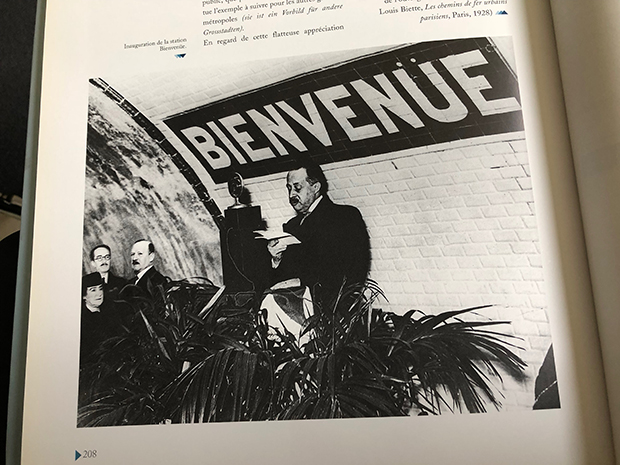
You are invited to come at the time that suits you, for the infinite time you want.
Find us, (-)auteur, and our hazard programming.
Your opened contribution is welcome.
Public artist, bring what drives you.
We will talk about the story of an ephemeral squat. A reflection in action, on life, on our ways of living. This invitation is the occasion to be together elsewhere, here.
Performances, acoustic concert, writing, games, gustatory experimentations, meeting between entities (-)auteur, between the living space of your bodies, of your voice in the space, the space you represent, the exhibition space, the square round table, pillows and maybe carpets, togas and drapes, text readings, exchanged words, sewing and weaving of all these stories.
Buffet cold at will, throughout the day.
(-)auteur
Opening of the exhibition Akademia : Performing Life
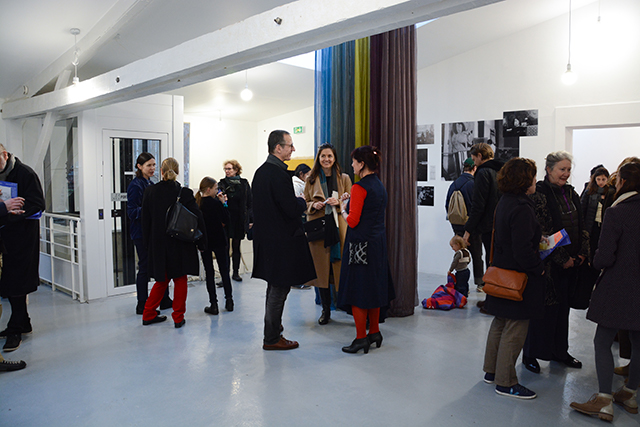
- Opening of the exhibition "Akademia : Performing Life", Villa Vassilieff, Paris, January 13, 2017. Image: Mathilde Assier.
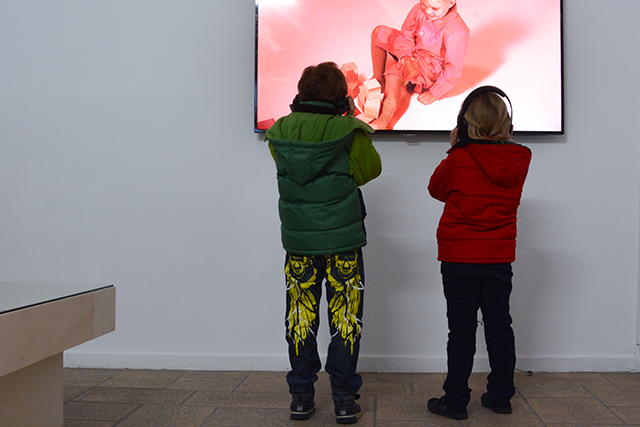
- Opening of the exhibition "Akademia : Performing Life", Villa Vassilieff, Paris, January 13, 2017. Image: Mathilde Assier.
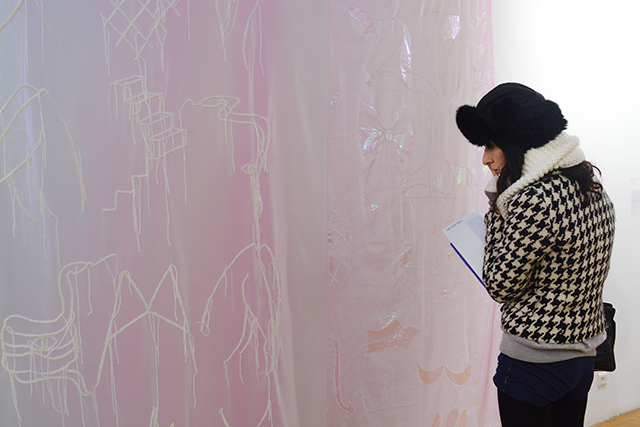
- Opening of the exhibition "Akademia : Performing Life", Villa Vassilieff, Paris, January 13, 2017. Image: Mathilde Assier.
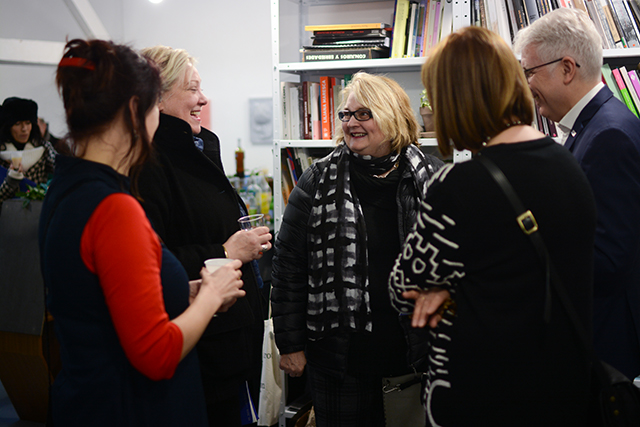
- Opening of the exhibition "Akademia : Performing Life", Villa Vassilieff, Paris, January 13, 2017. Image: Mathilde Assier.
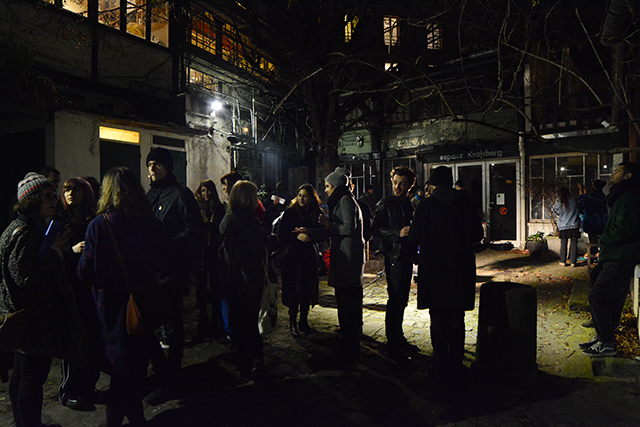
- Opening of the exhibition "Akademia : Performing Life", Villa Vassilieff, Paris, January 13, 2017. Image: Mathilde Assier.
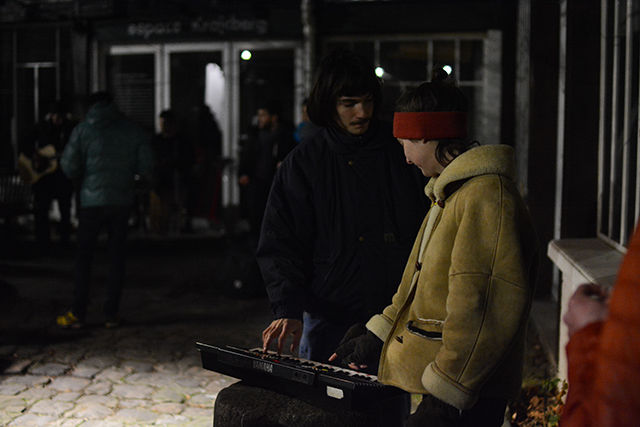
- Opening of the exhibition "Akademia : Performing Life", Villa Vassilieff, Paris, January 13, 2017. Image: Mathilde Assier.
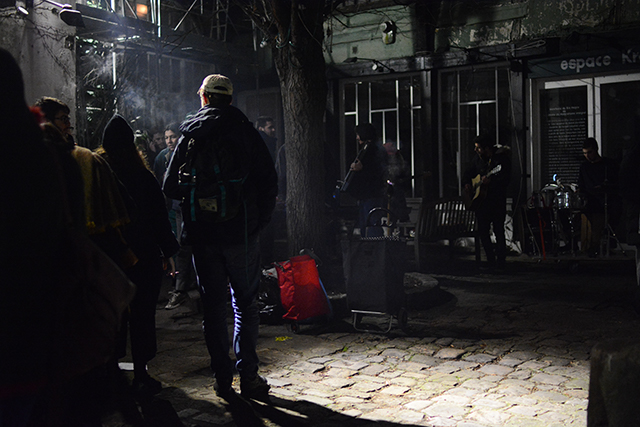
- Opening of the exhibition "Akademia : Performing Life", Villa Vassilieff, Paris, January 13, 2017. Image: Mathilde Assier.
Thursday, January 25 - 1 p.m
Lunch (-)auteur #1
Every two Thursdays at Villa Vassilieff, (-)auteur invites you over to discuss and contribute to the on-going story of squat H, as an invitation to have a hand in their publishing project.
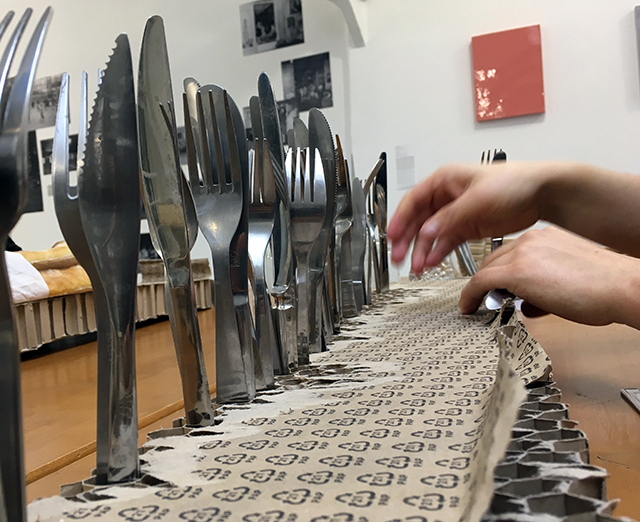
- Lunch (-)auteur, "Akademia : Performing Life", Villa Vassilieff, January 25, 2018. Image : Camille Chenais.
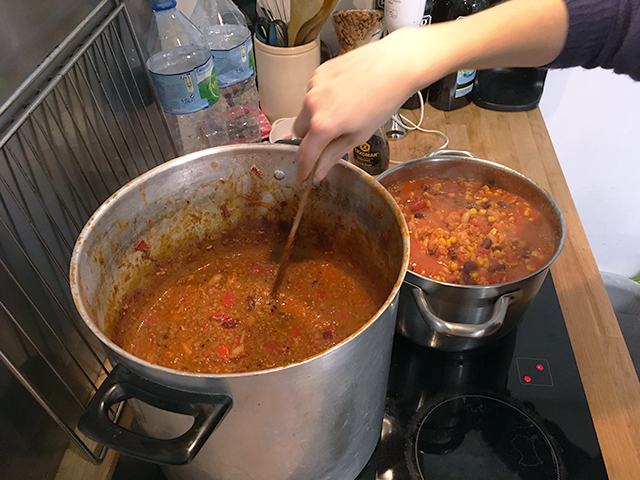
- Lunch (-)auteur, "Akademia : Performing Life", Villa Vassilieff, January 25, 2018. Image : Camille Chenais.
Thursday, February 08 - 1 p.m
Lunch (-)auteur #2
Every two Thursdays at Villa Vassilieff, (-)auteur invites you over to discuss and contribute to the on-going story of squat H, as an invitation to have a hand in their publishing project.
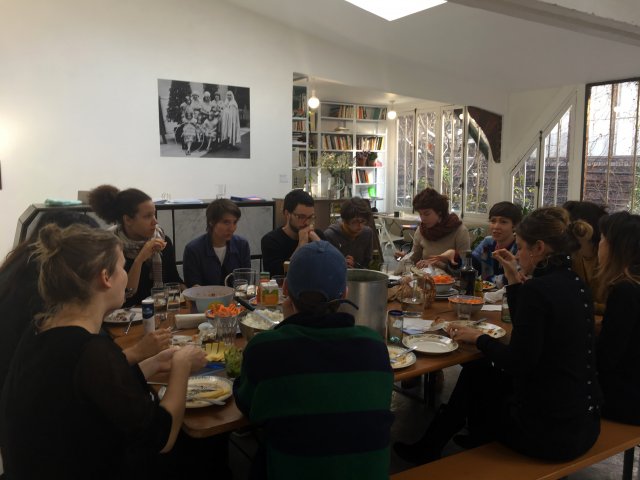
- Lunch (-)auteur, "Akademia : Performing Life", Villa Vassilieff, February 08, 2018. Image : Camille Chenais.
Thursday, February 22 - 1 p.m
Lunch (-)auteur #3
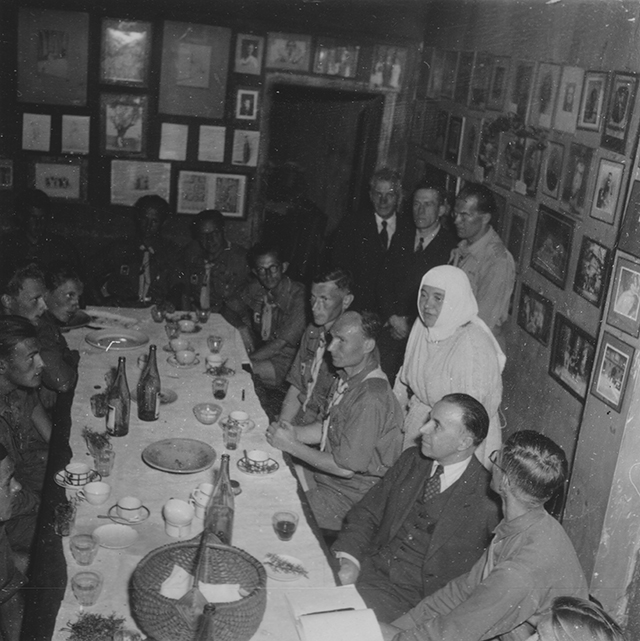
- Scouts at the Akademia canteen, unknown date. Courtesy: Duncan Collection
From 1pm for the ones who signed up with timely appetite
Every two Thursdays at Villa Vassilieff, (-)auteur invites you over to discuss and contribute to the on-going story of squat H, as an invitation to have a hand in their publishing project.
We will be here to share our para-artistic adventure of budding squatters, our artistic findings? Our emancipatory ideas, or simply, there to visit the current exhibition, read a book, look at what is or isn’t happening outside or to drink a glass of water or simply go to the bathroom...
On earth with other earthlings, in a white cloud*
From 11am to 7pm for exhibitions inhabitants
From 11.30am to 18.30pm to become fiction (-) auteur
*white cube or more commonly, white exhibition space
this cloud of the ACADEMY exhibition
Free of charge, twenty seats
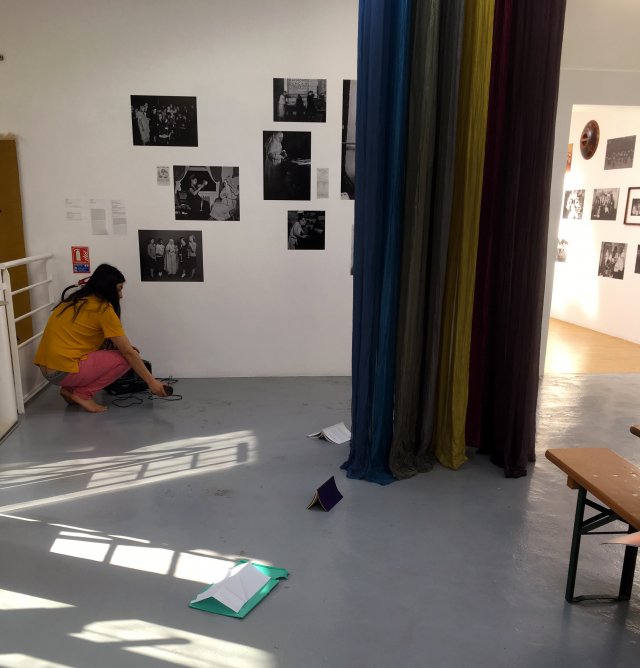
- Lunch (-)auteur, "Akademia : Performing Life", Villa Vassilieff, February 22, 2018. Image : Camille Chenais.
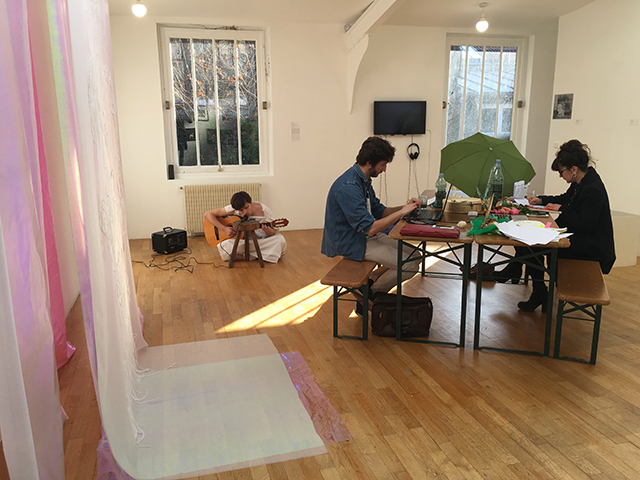
- Lunch (-)auteur, "Akademia : Performing Life", Villa Vassilieff, February 22, 2018. Image : Camille Chenais.
Saturday 24th of February, from 3pm to 6pm
LATEX, UNICORN, LANGUAGES: FOR A DISHONEST RESEARCH
Conversation with Mercedes Azpilicueta, Elisabeth Lebovici (to be confirmed), Inga Lāce and Virginie Bobin
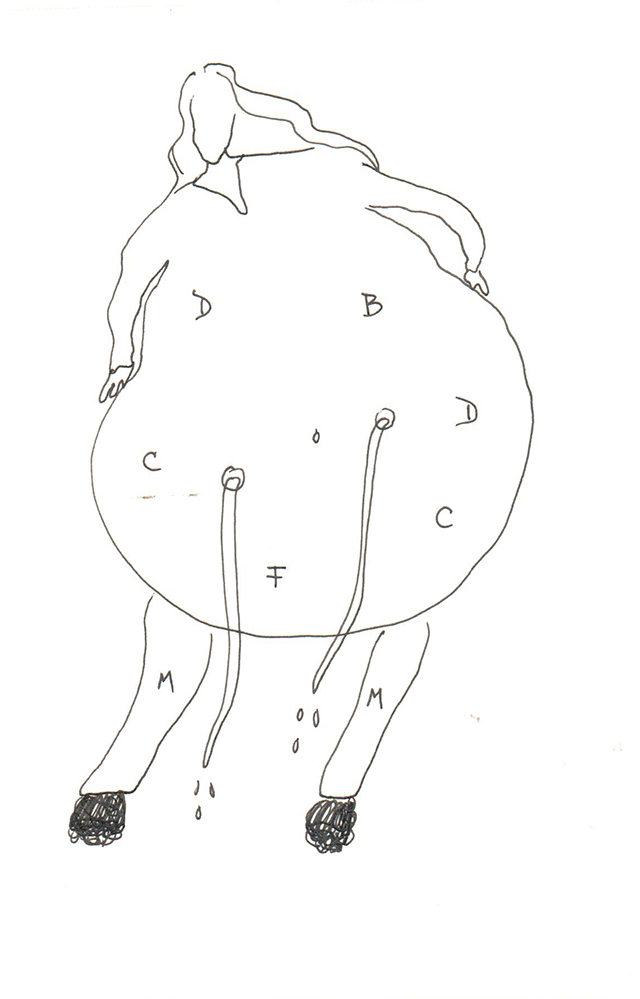
- Mercedes Azpilicueta, Untitled, 2018. Courtesy: Mercedes Azpilicueta
Argentinean artist Mercedes Azpilicueta presents herself as a "dishonest" researcher. During her residency at Villa Vassilieff as part of the Pernod Ricard Fellowship, she began writing a script for an upcoming performance, where she interlaces the work of the Franco-Argentinian artist Lea Lublin, the series of enigmatic tapestries The Lady and the Unicorn, the literary aesthetics of the Neobarroso Rioplatens, Chilean reggaeton, imaginary characters and vagrants of the underworld, as well as the theoreticians Suely Rolnik and Gloria Anzaldúa.
Mercedes Azpilicueta’s scenario was fueled by working sessions with the choreographer Pauline Simon, Jean-Baptiste Veyret-Logerias (performer and performance maker, and a practitioner of perceptive somatic-psychoeducation), the actress Emmanuelle Lafon, the artist and designer Lucile Sauzet, the filmmaker Hélène Harder as well as public workshops. It testifies to a research process that joyfully jumps genres, disciplines and eras, is embodied in multiple voices and languages, solicits the senses as much as the thought and welcomes the joy of a collective construction, wobbly and voluntarily corrupted.
The discussion will take place in the spaces of the exhibition Akademia : Performing Life, on view until the 24th of March at the Villa Vassilieff, in which Mercedes Azpilicueta presents Pink popping plank (2018), an artwork that is both sculpture, set, script and score to be activated.
Conceived by curators Solvita Krese, Inga Lāce (Latvian Center for Contemporary Art) and Camille Chenais (Villa Vassilieff), the exhibition Akademia: Performing Life itself composes a polyphonic narrative around the artistic community founded by Raymond Duncan, focusing on a lesser known figure, that of the Latvian dancer and writer Aia Bertrand. Like the weaves created by its self-taught members, the exhibition intertwines the threads of myth, curatorial and artistic research, and the subjective interpretation of the stories produced by and around the Akademia.
In the presence of filmmaker Hélène Harder, and with the participation of Raymond Duncan sandals, latex tumors, a unicorn and a few poems.
Languages: English, French, Spanish, Latvian ...
Mercedes Azpilicueta is a visual and performance artist from Argentina based in The Netherlands. Drawing on a transdisciplinary approach within her artistic practice, she develops projects that explore the affective qualities of language and voice, the political dimension of female desire, and the connections between embodiment, glocalities and resistance. Her work opts for personal and particular methodologies such as mnemonic and literary techniques, public soundscapes in relation to social and cultural conditions and the use of performative elements for producing knowledge, allowing processes where contingency, association and playfulness take place.
Élisabeth Lebovici is a historian, art critic, activist and writer. She has been a journalist at Libération, writing in its cultural column from 1991 to 2006. She wrote Femmes Artistes/Artistes Femmes (Hazan, 2007) in collaboration with Catherine Gonnard and runs the blog le beau vice.
In 2017, she published Ce que le sida m’a fait (What AIDS has done to me, Paris, Les presses du réel), an intimate and political account of intersections between art and activism, seen through the AIDS epidemic in the 1980s and 1990s in France and the United States.
Inga Lāce is a curator at the Latvian Centre for Contemporary Art (LCCA) and a curatorial fellow at de Appel arts centre, Amsterdam (2015-2016), where her examination of the intertwined relationships between nature and culture, and (art) institutions and ecology has led to the production of a symposium and a publication (forthcoming in 2017). She has recently curated the exhibitions Resilience. Secret Life of Plants, Animals and Other Species at Бükü (the Büro für kulturelle Übersetzungen) in Leipzig (2016), and Lost in the Archive, with Andra Silapetere, in Riga (2016), which took the LCCA’s archive of contemporary art as its starting point. She also curated the exhibition (Re)construction of Friendship (2014), which was held in the former KGB house in Riga. Lāce co-edited the book Revisiting Footnotes. Footprints of the Recent Past in the Post-Socialist Region with Ieva Astahovska (2015), and she was a curator,with Solvita Krese of the 7th and 8th editions of the contemporary art festival Survival Kit (2015- 2016).
February 27, 28 & March 1, 2, 4:30 P.M.
L’expérience, la trace et la recherche de l’œuvre
« People are not what they think they are, they are what they do » (R. Duncan)
Yaïr Barelli will start four appointments of 2h30 with a physical practice called “yoga” which will then drift, depending on the group, towards dance, song or speech, creating a common experience and a trace that will be called “artwork”.
Mandatory registration at publics(at)villavassilieff.net
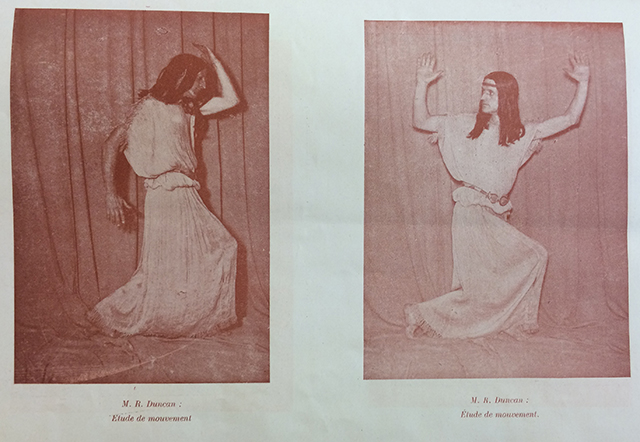
- Raymond Duncan, Kinetics studies. Phographic documentation for Akademia: Performing Life
Extracted from the periodical Græcia, undated. Available at BNF, Paris.
Yaïr Barelli in 1981, Jerusalem. Works and lives in Paris. He received training at the C.D.C in Toulouse and enrolled the programme Essais at the CNDC in Angers under the supervision of Emmanuelle Huynh. He works and collaborates with different artists and choreographers : Emmanuelle Huynh (Cribles), Marlène Monteiro Freitas (Paraiso- Colleçao Privada), Tino Sehgal (Instead of allowing some thing to rise up to your face dancing bruce and dan and other things), Jocelyn Cottencin (Monumental), Christian Rizzo (D’après une histoire vraie) and Jérôme Bel (Jérôme Bel).
He worked with Neal Beggs, collective åbäke, Pauline Bastard, Ivan Argote and lectures in several institutions, such as CNDC (Angers,France) The Place (London, Uk) , CN D (Pantin, France) and at the Haute École d’Art et Design (HEAD) in Geneva.
Current projects include Ce ConTexte, Sur l’interprétation - titre de l’instant et Le Magnifique aventure.
Saturday, March 3 at 3 p.m.
UTOPIA’S LEFTOVERS
Conversation with Corinne Giandou, Inga Lāce & Camille Chenais
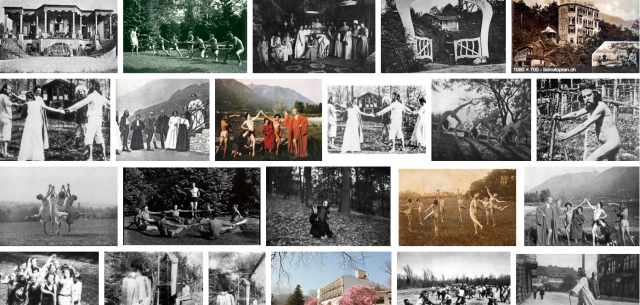
- Monte Verità via Google, on February 27, 2018, all right reserved.
As part of the exhibition Akademia: Performing Life, which explores the concepts and principles embodied by Akademia, we invite Inga Lāce, curator of the exhibition, and Corinne Giandou who worked alongside Harald Szeemann on Monte Verità, to share their experiences and methodologies in working around communities whose histories are volatile.
In the chaos of the archives, the interlacing of dates and places, the stories mixing facts, myths and prejudices, it is difficult to trace these histories. It is necessary to deploy, diffuse, interpret, romance, unravel, create and gather archives to sketch the stories of these two utopian attempts to build a community, these two laboratories of experiments both social, moral and artistic in connection with contemporary dance.
The story of Monte Verità was outlined by Harald Szeemann, who worked for six years on the exhibition Monte Verità, the breasts of the truth (Ascona 1978 then Zurich, Berlin, Vienna, Munich). Corinne Giandou met him in the mid-1990s and worked alongside him in the "factory" in the mountains of Ticino, a former restaurant and then cinema turned into a lighters factory before being bought by Szeemann. In its large halls without heating, he piled up masses of archives through which one had to find his/her way to access the many documents (letters, photocopies of police reports, theoretical writings, ...) objects and photographs collected by the curator, in particular from the descendants of the local population who had been in contact with the community.
The story of Akademia is yet to be written by exploring the family archives preserved between Massachusetts and New York, the writings published by the community and the artifacts preserved between Paris, Riga or even Budapest. Inga Lace will present her first explorations into this magma of places and sources and her collaboration with artists around this project.
Today, Monte Verità is a 332 meters tall hill perched above Ascona in the Swiss Canton of Ticino. Its name comes from a community of writers, painters, musicians, dancers, who came to settle on its flanks at the beginning of the century around Henri Oedenkoven (naturopath and patron), Ida Hoffmann (pianist) and Gustav Gräser (painter, poet, prophet). Rejecting industrialization, capitalism and the life produced by industrial and bourgeois society, they advocated for a return to nature, financial self-management, a vegetarian diet, daily gymnastics … Today, we know this community above all through the distribution of stereotypical images of bodies dressed in white or naked dancing and jumping in the mountains of Ticino. However, this society developed multiple activities: publication of theoretical texts (Provisional statuses of the vegetarian society of Monte Verità, Oedenkoven, 1905), culture of the land whose products were sold at the surrounding markets, dances, concerts or performances in the woods, building constructions (Casa Centrale, Casa Anatta, Casa Semiramis) which will become an inspiration for Bauhaus, ... But very quickly, the personal fortune of Oedenkoven and the sale of agricultural products at the markets are not enough anymore to support the needs of this alternative cooperative. In 1905, they open a sanatorium offering steam and mud baths, gardening activities, gymnastics or sunbathing. Even though the First World War inhibited the activities of this international community, it only disappeared definitively in 1920 when its indebted creators left the place. The buildings have been renovated and now house a luxury seminar center.
Akademia, behind this name hides an eclectic community, a school open to all, a nomadic space having known multiple addresses. Created in 1911 (1909? 1910? 1919?) by Raymond Duncan, it moved from one city to another (Montfermeil, Nice, Paris) and from one street to another (rue Campagne-Première, rue des Ursulines, rue du Colisée), before settling, in 1929, at 31 rue de Seine until the death of Raymond Duncan (1966) and then of Aia Bertrand (1977). This 16th-century, four-storey, courtyard house was home to a theater, a gallery, artists’ studios, living spaces and a «Duncans’ Museum» of artifacts and photographs depicting the life and career of the four Duncan siblings: Isadora, Elizabeth, Augustin and Raymond. At 31 rue de Seine there also was a letter press, used by Raymond Duncan to print numerous collections of poems, essays, pamphlets and magazines. The life of the Akademia was organized around many activities: dance, music, weaving, gymnastics, crafts, spinning, Orphic singing, Greek language and philosophy. These courses included outside students - who paid according to their means - and members of the community living within its walls for a few days, months or years. Housed and fed - following the vegetarian diet promoted by Duncan - the latter, in return, participated in the community economy by making sandals, spinning wool and weaving tunics on primitive looms. These artefacts were then sold - at high prices - in the Akademia shop located on rue du Faubourg Saint-Honoré. The community formed around Duncan was eclectic and cosmopolitan, yet, over the decades, Akademia and its ideals withered and stiffened. After 1945, the followers of 31 rue de Seine are above all aging people gathered around an increasingly narcissistic Raymond Duncan and Aia Bertrand, who will continue to support the school after the death of her husband.
Corinne Giandou is an art professional. She has worked in several cultural institutions in France, Belgium and Switzerland such as Espace Lyonnais d’Art Contemporain (Lyon, France), MAC and the Lyon Biennale (Lyon, France), CRAC Languedoc-Roussillon (Sète, France) as well as in Harald Szeemann’s personal archives (Maggia, Switzerland). She frequently lectures in art schools (Brussels, Lyon).
Inga Lāce is a curator at the Latvian Centre for Contemporary Art (LCCA) and a curatorial fellow at de Appel arts centre, Amsterdam (2015-2016), where her examination of the intertwined relationships between nature and culture, and (art) institutions and ecology has led to the production of a symposium and a publication (forthcoming in 2017). She has recently curated the exhibitions Resilience. Secret Life of Plants, Animals and Other Species at Бükü (the Büro für kulturelle Übersetzungen) in Leipzig (2016), and Lost in the Archive, with Andra Silapetere, in Riga (2016), which took the LCCA’s archive of contemporary art as its starting point. She also curated the exhibition (Re)construction of Friendship (2014), which was held in the former KGB house in Riga. Lāce co-edited the book Revisiting Footnotes. Footprints of the Recent Past in the Post-Socialist Region with Ieva Astahovska (2015), and she was a curator,with Solvita Krese of the 7th and 8th editions of the contemporary art festival Survival Kit (2015- 2016).
Thursday, March 8 - 1 p.m
Lunch (-)auteur #4
Every two Thursdays at Villa Vassilieff, (-)auteur invites you over to discuss and contribute to the on-going story of squat H, as an invitation to have a hand in their publishing project.
Free of charge, twenty seats
RSVP publics(at)villavassilieff.net
Saturday, March 10 at 3 p.m.
Aias , 3 - 5 p.m.
Since 2010, Myriam Lefkowitz, performance artist and choreographer, has been researching the question of attention and perception through various immersive devices that involve direct relationship and engagement between the spectator and artist.
Myriam Lefkowitz is principally interested in the invention of attention regimes that are rooted in nonverbal communication. Focusing on haptic phenomena and blinking eyes, she seeks to deploy and share the political potential of the resources contained in different forms of liminality, between sleep and wakefulness.
With Aias, Myriam Lefkowitz seeks to make contact with the ghostly figure of Aia Bertrand (who was shadowed by the imposing and megalomaniac figure of her husband, Raymond Duncan) and of the Akademia, through guides who will be the hosts.
At La Galerie (Noisy-le-Sec), Myriam Lefkowitz conducted a series of individual sessions using a form of dialogue, similar to the practice of hypnosis to appeal to an augmented imaginative activity, to which the spectator could immediately testify, where she offered a group of acolyte artists (Héléna De Laurens, Jean-Philippe Derail,Charlotte Imbault, Catalina Insignares, Thierry Gropotte, Julie Laporte, Anne Lenglet, Florian Richaud, Lina Schlageter, Jean-Baptiste Veyret-Logerias et Yasmine Youcef) to incorporate one of the possible lives of Aia and Akademia. Their perceptions, sensations, memories, images, thoughts, gestures thus become the vectors, the supports and the archives of an oral, affective, informal, elliptical story about a ghost invited to haunt the art center.
On March 10, at Villa Vassilieff, each of these artists carrying one of the possible lives of Aia and the Akademia, will share their memory of the story born from these hypnosis sessions. Through an association game, they will weave a possible collective mind map of the school which will evolve over the time of this public meeting.
Project supported by La Galerie, Center for Contemporary Art, Noisy-le-Sec and the DRAC Ile-de-France / Ministry of Culture for choreographic residencies.
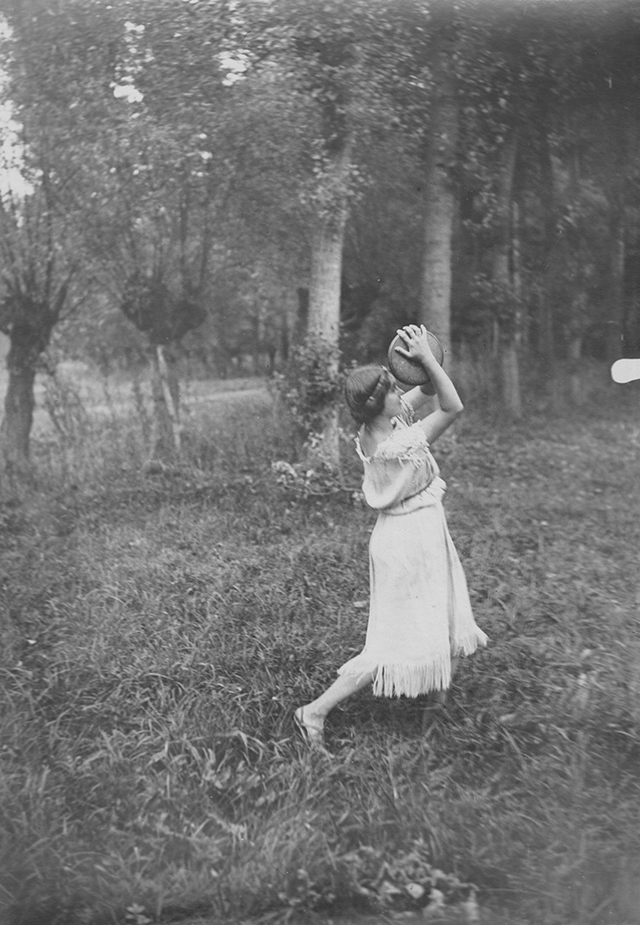
- Aia Bertrand in Montfermeil, 1910’s. Courtesy: Duncan Collection, all rights reserved.
Artist associated to the second edition of the magazine watt, Myriam Lefkowitz invites to Villa Vassilieff the launch of the magazine, with whom multiple participants to Aias have collaborated.
Launch of the second number of the magazine watt, 5 - 7 p.m.
Where, dance? The bilingual magazine (fr./eng.) which is interested in bringing to life, for the performative arts, an open-air studio where the artists deploy a space to speak about the making and the material of the work, focuses for its second issue on the question of how to dance without performing. Since its first issue, the magazine has privileged the interview form by thinking about the act of speaking as a learning process that allows elements that were not, or not yet, identifiable in practice to emerge. For this second launch: discussions, drinks and petits fours!
Issue coordinated by Charlotte Imbault and Sandrine Fuchs with the participation of Lisa Nelson, The Bureau for the Future of Choreography, Nobody’s Business, Barbara Manzetti, Carolina Mendonça, Alexandra Pirici, Valentina Desideri, Catalina Insignares, Yasmine Youcef and Myriam Lefkowitz.
Saturday, March 17 at 3 p.m.
Faire école
Conversation with Yann Chateigné and Anna Colin
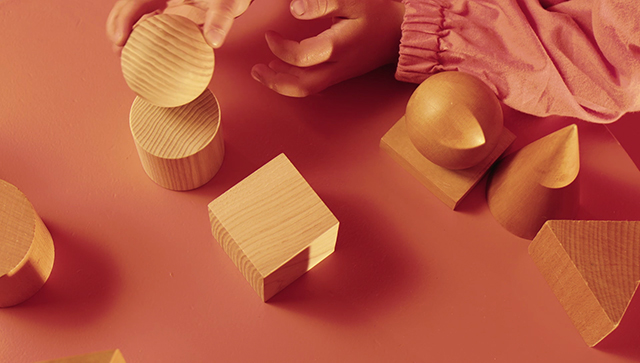
- Ieva Epnere, Green school, 2017, HD video. Courtesy Ieva Epnere
As part of the exhibition Akademia: Performing Life which explores the notions and principles embodied by Akademia, a community and school created by Raymond Duncan, we invite Anna Colin (curator, educator and researcher, co-director of Open School East) and Yann Chateigné (Professor of Art History and Theory and Researcher at the Geneva School of Art and Design (HEAD) to share their work experiences and their reflections on the issues of transmission in art. What can be passed down? How to create physical and mental spaces for horizontal and open exchanges?
Yann Chateigné is Professor of History and Theory of Art and Researcher at the Geneva School of Art and Design. Between 2009 and 2017, he was Head of the Visual Arts Department of HEAD - Genève, where he was also in charge of the programming of LiveInYourHead, his curatorial institute, of Fieldwork: Marfa, an international research residence located in Marfa, Texas as well as the HEAD / ISR Summer Academy, at the Istituto Svizzero di Roma. Curator, critic, he was chief curator at the CAPC Centre of Contemporary Art in Bordeaux (2007 - 09), curator at the Délégation aux Arts Plastiques (2001 - 07) and the Pompidou Center / National Museum of Modern Art in Paris ( 2000 - 01). Recent projects include: 1977 (L’Onde, Vélizy, on the occasion of the 40th anniversary of the Pompidou Center Paris, 2017), the Biennale de l’Image en Mouvement (Centre d’art contemporain Genève, 2014, with Andrea Bellini and Hans Ulrich Obrist), La vie matérielle (Fondation d’entreprise Ricard, Paris, 2013), Panegyric (Forde, Geneva, 2012), The Mirage of History (Pacific Cinematheque, Vancouver, Kaleidoscope Project Space, Milan; Whitechapel Art Gallery, London, 2010-13). His texts have been published in Artforum, Frieze, Mousse and Spike, as well as in several thematic works and monographic publications.
Anna Colin is a curator, educator and researcher. She co-founded and co-directs Open School East in Margate (UK), works as associate curator at Lafayette Anticipations – Fondation d’entreprise Galeries Lafayette in Paris, and is a PhD candidate in the School of Geography at the University of Nottingham, where she is researching alternative learning, social and arts centres in the UK, the US and further afield, from the late 19th century to the present. Anna was co-curator, with Lydia Yee, of the touring exhibition British Art Show 8 (Leeds, Edinburgh, Norwich and Southampton) in 2015-16. Previously, she was associate director of Bétonsalon, Paris (2011-12) and curator of Gasworks, London (2007-10).
Open School East is a space for artistic learning that is free, experimental, collaborative and brings together diverse voices. We provide tuition and studio space to emerging artists, run learning activities for young people and adults, commission artists to develop participatory projects, and produce and host cultural events and social activities for and with everyone. Open School East was founded in 2013 in East London and relocated to Margate, Kent in 2017. It is committed to making the arts a more open sector and to fostering cultural and social exchanges between artists and the broader public.
Partager